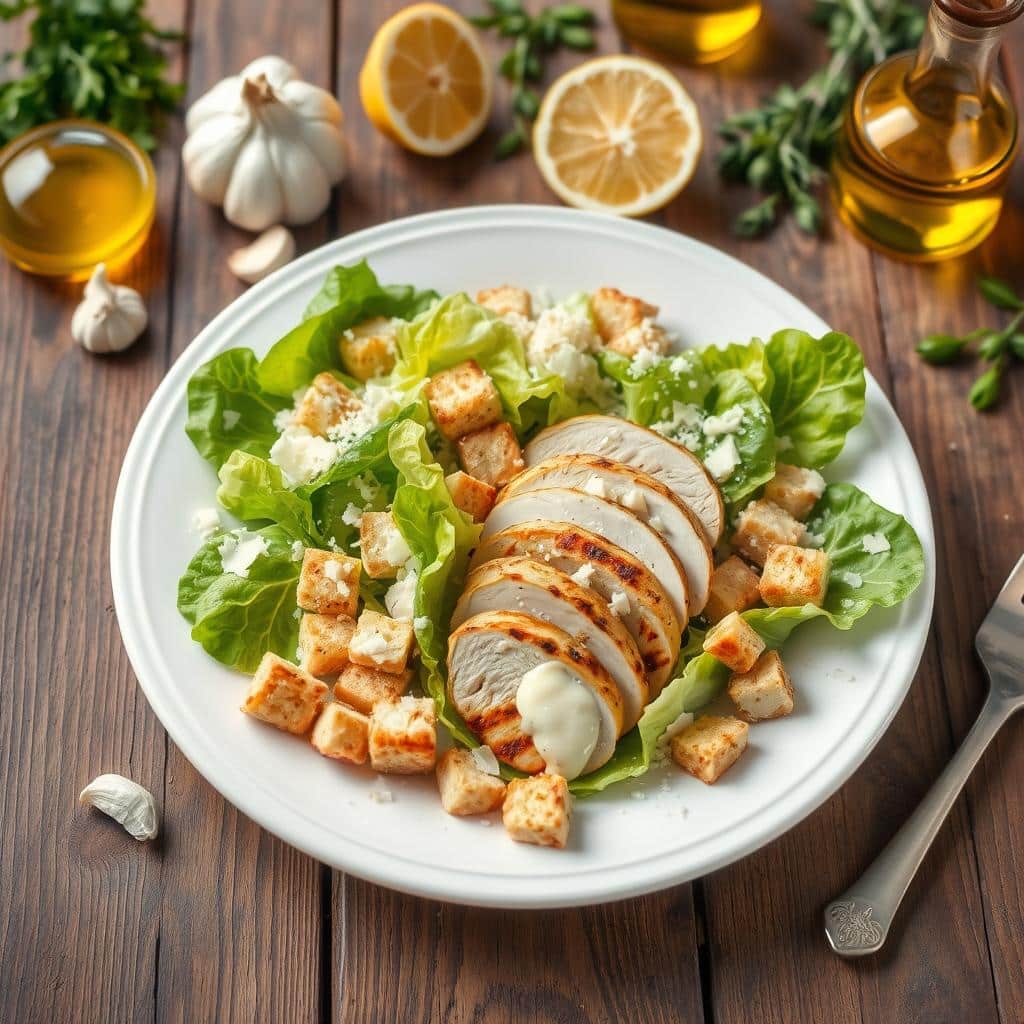As the afternoon sun sets, the smell of grilled chicken and fresh greens fills the air. You can’t help but want a Chicken Caesar Salad. This dish is loved in many homes and restaurants for its health and taste. But, have you thought about the real nutritional value of your favorite salad?
In this guide, we’ll look at what makes a Chicken Caesar Salad special. We’ll explore the traditional ingredients, new twists, and the nutritional facts. Whether you’re watching your diet or just curious, this article will give you the info you need. You’ll learn to enjoy every bite more.
Key Takeaways
- Understand the key components that make up a Chicken Caesar Salad and their nutritional benefits.
- Explore the range of traditional and modern variations, along with portion size guidelines.
- Dive deep into the comprehensive nutritional analysis, including protein, carbohydrates, fiber, and essential vitamins and minerals.
- Learn about the potential health benefits and considerations for special diets.
- Discover smart modifications to make your Chicken Caesar Salad even healthier.
Understanding the Classic Chicken Caesar Salad Components
Chicken caesar salad is a favorite dish. It mixes grilled or roasted chicken, crisp romaine lettuce, crunchy croutons, and creamy caesar dressing. Knowing the origins and nutritional values of these ingredients helps you understand your salad’s nutrition.
Traditional Ingredients and Their Sources
The classic chicken caesar salad includes:
- Romaine lettuce – This green is the salad’s base, packed with fiber, vitamins, and minerals.
- Grilled or roasted chicken breast – The chicken adds protein and a savory taste.
- Croutons – These bread cubes add crunch and carbs.
- Parmesan cheese – The cheese brings a salty, umami flavor.
- Caesar dressing – Made with olive oil, lemon juice, garlic, and anchovies, it’s creamy and tangy.
Modern Variations and Substitutions
There are many ways to make chicken caesar salad your own. You can try:
- Using grilled or blackened salmon or shrimp for a seafood twist.
- Switching romaine lettuce for kale, spinach, or mixed greens.
- Choosing whole-grain croutons or skipping them for less carbs.
- Trying different dressings, like yogurt-based or vegan caesar.
Portion Size Guidelines
The size of your chicken salad matters. A typical serving is 2 cups. This size balances protein, carbs, and fats. But watch the dressing and croutons, as they can add too many calories and fat.

The Complete Nutritional Value of Chicken Caesar Salad
If you love chicken caesar salad, you’ll be happy to know it’s good for you. It has grilled or roasted chicken, crisp romaine lettuce, croutons, and creamy caesar dressing. These ingredients give you important nutrients for your health.
Let’s look at the nutritional value of a typical chicken caesar salad. This breakdown will show you calories, macronutrients, and vitamins and minerals in this favorite dish.
| Nutrient | Amount per Serving |
|---|---|
| Calories | 400-550 calories |
| Protein | 30-40 grams |
| Carbohydrates | 20-30 grams |
| Fat | 25-35 grams |
| Fiber | 5-8 grams |
| Vitamin A | 60-80% of the Daily Value (DV) |
| Vitamin C | 15-25% of the DV |
| Calcium | 15-25% of the DV |
| Iron | 10-15% of the DV |
A chicken caesar salad is a nutritious choice, full of protein, fiber, and vitamins. But, the exact values can change based on ingredients and portion size.

Knowing the nutritional value of a chicken caesar salad helps you make better food choices. You can enjoy this classic dish as part of a healthy diet.
Protein Content: Building Blocks for Your Body
Chicken caesar salad is known for its high protein content. Protein is key for fixing and growing body cells. It also helps with many body functions. Let’s explore the protein-rich parts of this favorite salad.
Chicken Breast Protein Profile
The main star of the chicken caesar salad is the chicken breast. It’s lean and full of good amino acids. A 3-ounce serving has about 26 grams of high-protein caesar salad.
Additional Protein Sources in Caesar Salad
While chicken is the main protein source, other ingredients add more. Shredded parmesan cheese adds 3-4 grams of protein. Hard-boiled eggs are also a great protein source.
Together, chicken and other protein-rich ingredients make a satisfying meal. They provide a lot of caesar salad protein your body needs.
Carbohydrates and Fiber Analysis
The nutritional value of a chicken caesar salad includes its carb content. This dish has many ingredients, each adding to its carb and fiber levels.
The caesar salad carbs mainly come from romaine lettuce, croutons, and caesar dressing. Romaine lettuce has a bit of complex carbs. Croutons, made from bread, have simple carbs from refined grains.
The nutritional value of chicken caesar salad also benefits from its fiber. Romaine lettuce is rich in dietary fiber, aiding digestion and keeping you full. Grilled or roasted chicken breast adds a bit more fiber to the dish.
| Nutrient | Amount per Serving |
|---|---|
| Carbohydrates | 12g |
| Fiber | 3g |
The exact caesar salad carbs and fiber can change based on ingredients, portion size, and how it’s made. Enjoying a chicken caesar salad means watching the carb and fiber balance. This ensures it meets your dietary needs and preferences.
Fat Content and Caloric Breakdown
The nutritional profile of a chicken caesar salad is key. Knowing the fat and calorie count helps you choose a healthier meal. It’s all about balancing good and bad fats and the impact of dressing.
Understanding Good vs. Bad Fats
Fats in a chicken caesar salad come from chicken, dressing, and toppings. It’s vital to know the difference between good fats and bad fats. Good fats, like those in avocado and olive oil, are healthy. Bad fats, like saturated and trans fats, should be avoided.
Impact of Dressing on Fat Content
The caesar salad dressing greatly affects the dish’s fat and calorie count. Traditional caesar dressing, made with mayonnaise, is high in fat. Choosing a lighter dressing or using less can cut calories without losing flavor.
| Salad Dressing | Fat (grams) | Calories |
|---|---|---|
| Traditional Caesar Dressing | 10-15 g | 120-180 cal |
| Lighter Caesar Dressing | 5-8 g | 60-100 cal |
By understanding the fat and calorie content of a chicken caesar salad, you can enjoy it healthily. Smart substitutions make this classic dish part of a balanced diet.
Essential Vitamins and Minerals Found in Caesar Salad
Chicken caesar salad is packed with vitamins and minerals. It’s a treasure trove of nutrients that boost your health. This salad is full of micronutrients that keep you feeling great.
The romaine lettuce is a big source of vitamins A and K. It gives you a lot of what you need each day. The chicken breast is also a lean protein that adds vitamin B6 and niacin. These help with energy and keeping your immune system strong.
The creamy caesar dressing has vitamin E. This antioxidant protects your cells. The Parmesan cheese adds calcium and phosphorus for strong bones and teeth.
This salad also has iron and folate. Iron helps carry oxygen in your body. Folate is a B-vitamin for cell growth and development.
| Nutrient | Amount in Chicken Caesar Salad | % of Daily Recommended Intake |
|---|---|---|
| Vitamin A | 5,070 IU | 101% |
| Vitamin K | 122 mcg | 153% |
| Vitamin B6 | 0.5 mg | 25% |
| Niacin | 5.7 mg | 36% |
| Vitamin E | 2.7 mg | 18% |
| Calcium | 291 mg | 29% |
| Phosphorus | 296 mg | 30% |
| Iron | 2.1 mg | 12% |
| Folate | 97 mcg | 24% |
Adding chicken caesar salad to your meals is good for your taste buds and body. It’s a delicious way to get essential vitamins and minerals. Enjoy this classic dish and support your health and wellness.
Health Benefits and Potential Concerns
Chicken caesar salad is a nutritious and tasty meal. It’s packed with health benefits. When made with care, it’s a great choice for a balanced diet.
Positive Health Impacts
This dish combines lean chicken, fiber-rich greens, and healthy fats. These elements offer several benefits:
- It supports muscle growth and maintenance with high-quality chicken protein.
- The romaine lettuce boosts gut health and digestion.
- It helps control cholesterol and lowers heart disease risk with its monounsaturated fats.
- The vitamins and minerals in the salad ingredients boost immune function and overall health.
Considerations for Special Diets
Chicken caesar salad is generally healthy. But, it’s crucial to consider certain dietary needs or health conditions:
- Allergies and Intolerances: It may contain dairy from parmesan cheese or eggs in the dressing. This could be a problem for those with food sensitivities.
- Sodium Intake: The dressing and parmesan cheese are high in sodium. This is a concern for those with high blood pressure or heart issues.
- Weight Management: The salad’s calorie and fat content, especially in large portions or with creamy dressing, should be considered for weight management.
Knowing these concerns and making smart substitutions or portion adjustments can help. This way, you can enjoy a healthy caesar salad that meets your dietary needs and health goals.
Making Your Caesar Salad Healthier: Smart Modifications
Make your healthy caesar salad better by changing a few things. You can cut calories or add more nutrients. These easy changes can make your salad a healthier meal.
Swap the Dressing
The caesar dressing is often high in calories and fat. Try a low-calorie caesar dressing instead. Use Greek yogurt, lemon juice, and Dijon mustard. It tastes like the original but is healthier.
Embrace Leafy Greens
Romaine lettuce is key in a caesar salad. But add spinach or kale too. They add fiber, vitamins, and minerals to your low-calorie caesar salad.
Go Easy on the Croutons
Croutons add crunch and flavor but lots of calories. Eat less of them or choose whole-grain ones. This makes your salad healthier and more balanced.
Portion Control is Key
Even with healthier choices, watch your portions. Eat 1-2 cups of salad. This way, you enjoy a healthy caesar salad without eating too much.
| Ingredient | Healthier Modification |
|---|---|
| Dressing | Use a low-calorie, yogurt-based caesar dressing |
| Greens | Incorporate nutrient-dense greens like spinach or kale |
| Croutons | Reduce portion or use whole-grain alternatives |
| Portion size | Stick to a 1-2 cup serving for a balanced meal |
These simple changes can make your healthy caesar salad even better. Try different ingredients to find the perfect mix for you.
Comparing Restaurant vs. Homemade Nutritional Values
When it comes to chicken caesar salad nutrition facts, there are big differences between restaurant and homemade versions. Knowing these differences helps you make better choices about the nutritional value of a caesar salad bowl.
Restaurant chicken caesar salads have bigger portions. They have lots of creamy dressing, crispy croutons, and protein-rich chicken. These add flavor but also more calories, fat, and sodium than homemade salads.
| Nutrient | Restaurant Caesar Salad | Homemade Caesar Salad |
|---|---|---|
| Calories | 800-1,000 | 400-600 |
| Total Fat | 50-70g | 25-35g |
| Sodium | 1,200-1,500mg | 800-1,000mg |
Homemade chicken caesar salads let you control the size and ingredients. You can use less dressing, choose whole-grain croutons, and grill the chicken. This makes a healthier and more balanced meal.
Whether eating out or making your own caesar salad, pay attention to the nutritional value. This helps you make healthy choices for your well-being.
“The secret to a perfect caesar salad is all in the dressing and the quality of the ingredients.”
Special Dietary Considerations and Alternatives
Chicken caesar salad is a favorite, but it can be tricky for those with dietary restrictions. Luckily, you can make it work for gluten-free, dairy-free, and vegetarian diets. Just a few tweaks can make it fit your needs.
Gluten-Free Alternatives
Gluten-free folks might worry about the croutons in traditional caesar salads. But, you can use gluten-free croutons like roasted chickpeas or almond flour ones. They add crunch without the gluten.
Dairy-Free Options
For those avoiding dairy, the dressing is a hurdle. Try using plant-based mayonnaise as a base. Add cashews, lemon juice, and garlic to get that creamy, tangy taste.
Vegetarian Versions
Vegetarians can swap chicken for protein-rich options like grilled tofu, roasted chickpeas, or crispy falafel. These alternatives offer a tasty and protein-packed substitute.
With these easy changes, you can enjoy a delicious and healthy caesar salad. Whether you’re looking for a low-calorie option or one that fits your dietary needs, there are plenty of choices.
| Dietary Need | Ingredient Substitutions |
|---|---|
| Gluten-Free | Gluten-free croutons, such as roasted chickpeas or almond flour croutons |
| Dairy-Free | Plant-based, dairy-free mayonnaise, cashews, lemon juice, and garlic for the dressing |
| Vegetarian | Grilled tofu, roasted chickpeas, or crispy falafel instead of chicken |
With a bit of creativity, you can enjoy a healthy caesar salad that meets your dietary needs. It’s all about finding the right ingredients.
Conclusion
In this article, we’ve looked at the chicken caesar salad and its nutritional value. It’s packed with protein, carbs, fiber, and important vitamins and minerals. Knowing what’s in it helps you choose it wisely for your diet.
Whether you stick to the original recipe or try new twists, chicken caesar salad is a great choice. Pay attention to how much you eat and what dressing you use. This way, you can enjoy its health benefits while meeting your dietary needs.
Remember, the nutritional value of chicken caesar salad is just part of the story. A varied and balanced diet is key to keeping your body healthy. Feel free to customize this classic dish to fit your taste and dietary needs.
FAQ
What is the nutritional value of a chicken caesar salad?
A chicken caesar salad is packed with nutrients. It has protein, carbs, and vitamins and minerals. It includes chicken, lettuce, croutons, parmesan cheese, and creamy caesar dressing.
How many calories are in a chicken caesar salad?
The calories in a chicken caesar salad vary. It can have 400 to 800 calories. The dressing and croutons add most of the calories. Choosing a lighter dressing and less croutons can lower the calorie count.
How much protein is in a chicken caesar salad?
A chicken caesar salad has about 30-40 grams of protein. This comes mainly from the chicken. Chicken is a lean protein that supports muscle and overall health.
What is the fat content of a chicken caesar salad?
The fat in a chicken caesar salad depends on the dressing. Traditional caesar dressing has oil, which adds fat. But, using a lighter or oil-free dressing can reduce fat.
How many carbs are in a chicken caesar salad?
A chicken caesar salad has 20-40 grams of carbs. Most of this comes from croutons and vegetables. The lettuce adds complex carbs and fiber.
What are the main nutrients in a chicken caesar salad?
A chicken caesar salad is rich in vitamins and minerals. It has vitamin A, vitamin C, calcium, and iron. The lettuce, parmesan cheese, and chicken all contribute to its nutritional value.
What are the benefits of eating a chicken caesar salad?
Eating a chicken caesar salad can be good for you. It has protein, carbs, and healthy fats. It also has vitamins and minerals. This mix can be satisfying and support health when part of a balanced diet.
How can I make a chicken caesar salad healthier?
To make a chicken caesar salad healthier, try these tips:
– Use grilled or roasted chicken instead of fried
– Choose a lighter, oil-free caesar dressing
– Limit the amount of croutons
– Add more vegetables, such as tomatoes, cucumbers, or bell peppers
– Use a smaller portion size
– Opt for a side salad instead of a full-sized entree salad

